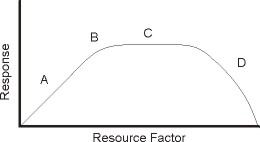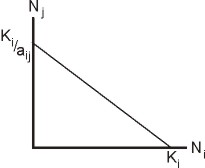| BIO226 : Predation/Competition : Competition : Lesson | ||||
| BIO226 : Predation/Competition : Competition : Lesson | ||||
 |
Glossary terms that are important in this lesson:
Allelopathy, asymmetry, competition coefficient, competitive coexistence, competitive exclusion, equilibrium, exploitation competition, interference competition, interspecific competition, intraspecific competition, isocline, keystone predator, Liebig's law of the minimum, limiting factors, Lotka-Volterra equation, parasitoid. |
Competition occurs when individuals share a resource which is in short supply. Sometimes competition is a head-to-head confrontation, but more often one individual uses a resource before another individual gets to it and deprives the other of something it needs.
I. Competition
|
 |
II. Theory of Competition
|
 |
III. Competition in Nature
IV. Mechanisms of Competition
When you have completed this lesson, go on to Review Questions
 Copyright 1998
Northern Arizona University
Copyright 1998
Northern Arizona University